
Making Mars a nicer placeby Eric Choi
|
| Arthur C. Clarke’s 1952 novel The Sands of Mars was the last in which the planet would bear any resemblance to the world depicted by Burroughs and Bradbury. |
Terraforming is the process of altering the present climate of Mars (or any other inhospitable planet) into a more Earth-like environment suitable for human settlement. While Kim Stanley Robinson’s Red Mars/Green Mars/Blue Mars trilogy is perhaps the best-known and most ambitious work of science fiction to describe how terraforming could make Mars a nicer place, it certainly wasn’t the first. Starting with A Princess of Mars in 1917, Edgar Rice Burroughs wrote eleven novels that portrayed an arid world he called Barsoom made habitable by an “atmosphere factory”1 (these books were the basis for the recent Disney movie John Carter). The stories in Ray Bradbury’s 1950 collection The Martian Chronicles were set on a desert planet crisscrossed with canals built by an alien civilization to distribute water from the polar caps.2
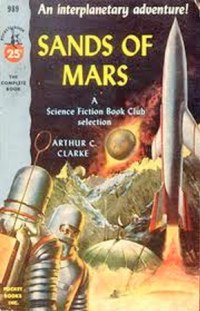 (credit: Pocket Books) |
Arthur C. Clarke’s 1952 novel The Sands of Mars was the last in which the planet would bear any resemblance to the world depicted by Burroughs and Bradbury. The protagonist was a science fiction writer who traveled to Mars to research a new book. The colony there was stable and generally healthy, although individuals sometimes suffered from “Martian fever”, a malaria-like illness caused by a terrestrial organism that had been accidentally carried to Mars and ended up thriving in the new environment. The protagonist became involved with the planet’s political difficulties with Earth, survived an airplane crash during a giant dust storm, discovered an indigenous non-photosynthetic plant species that could extract oxygen from the Martian regolith, and uncovered a secret plan to terraform Mars called “Project Dawn”3 (all in a sol’s work for a science fiction author!).
To modern readers, the most obvious problem with Project Dawn is that we now know there are (regrettably) no indigenous plants on Mars to provide oxygen. Clarke’s novel was, however, correct in concluding that the most feasible mechanism for changing the bulk composition of the Martian atmosphere is planetary-scale biology. Since no indigenous biology exists to accomplish this, the required organisms would have to be genetically engineered and introduced to the planet.4
Thirteen years after the publication of The Sands of Mars, the Mariner 4 spacecraft conducted the first successful flyby of the Red Planet and returned images that revealed a desolate-looking and apparently lifeless landscape. Those images, and the pictures from subsequent Mariner missions, culminating in the ambiguous results from the Viking Landers’ life detection experiments in 1976, forever swept away the romantic Barsoom and did much to diminish the general public’s interest in Mars. Fortunately, Mars fiction has been enjoying a renaissance of late, coinciding with a resurgence of new missions to the Red Planet such as the recent successful landing of NASA’s Curiosity (Mars Science Laboratory) rover. The 1990s saw numerous works about human missions to Mars, such as Ben Bova’s Mars5 and Gregory Benford’s The Martian Race6, and also the emergence of a terraforming sub-genre.
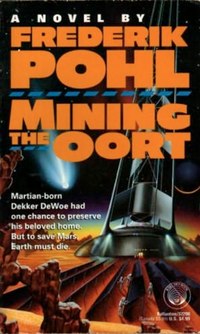 (credit: Ballantine Del Rey) |
“There isn’t anything much wrong with Mars that a decent atmosphere won’t fix right up”7 was the memorable opening line of Frederik Pohl’s novel Mining the Oort, in which comets in the Oort Cloud were harvested as a source of volatiles for a terraforming project. While Pohl’s description of mining the comets was generally accurate, the main problem with the concept is the extreme distance of the Oort Cloud, which is estimated to extend from about 40,000 to 100,000 AU from the Sun (six to fifteen trillion miles).8 In his book Disturbing the Universe, physicist Freeman Dyson suggested mining ice from the Saturnian moon of Enceladus.9 Another possible source of volatiles is the Kuiper-Edgeworth Belt. As it is “only” 30 to 50 AU (4.5 to 7.5 billion miles) away from the Sun10, it may be a (somewhat) more accessible source of icy planetesimals than the Oort Cloud.
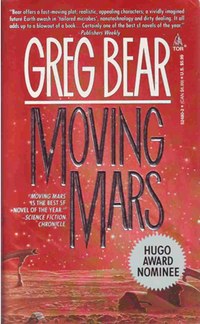 (credit: Tor) |
A fantastic sort of terraforming was portrayed in Greg Bear’s novel Moving Mars, in which the planet is transported to the habitable zone of another star system courtesy of some very exotic physics. A group of Martian physicists constructed a “tweaker” that could directly manipulate the “descriptors” which encode the basic properties of matter and energy. Using the tweaker, the position descriptors of Mars were changed, placing the planet into an orbit around a yellow dwarf star about nine-tenths the size of the Sun located thousands of light-years from the Solar System. Since Mars now orbited closer to the new star than it did to the Sun, it immediately became a much nicer place for humans to live.
| Kim Stanley Robinson’s Red Mars/Green Mars/Blue Mars trilogy is considered by many to represent the pinnacle of the terraforming sub-genre. |
The idea of the tweaker appears to have been inspired by Ed Fredkin, a former MIT professor who produced some controversial hypotheses on the nature of reality. Our everyday experience tells us that information can be represented by either matter or energy. But Fredkin speculated that the opposite might be true, that matter and energy are actually manifestations of information. Under such an interpretation, the properties of matter and energy are bits, the scientific laws that govern physical systems are algorithms that affect those bits, and reality is just a program running on a computer called the Universe.11
Kim Stanley Robinson’s Red Mars/Green Mars/Blue Mars trilogy is considered by many to represent the pinnacle of the terraforming sub-genre. Published between 1992 and 1996, the novels chronicled the transformation and settlement of the Red Planet while describing its long-term consequences. A fourth book, The Martians, was published in 1999 as a collection of stories set in the same universe as the trilogy.
Robinson’s epic began in 2026, when a crew known as the First Hundred undertook a mission to colonize and terraform Mars. Once the initial settlements were constructed and the terraforming process was started, new immigrants from various nations joined the original pioneers. But the settlers fractured into two camps: the Greens, who wished to pursue terraforming at any cost, and the Reds, who wanted to keep Mars in its pristine condition. This division, combined with rising tensions with Earth and ethnic rivalries amongst the settlers, eventually erupted into revolution.
Robinson’s trilogy was very well received, with the first book winning a Nebula Award and the other two taking Hugos. Indeed, the novels seem to be regarded with near-Biblical reverence by some members of groups like the Mars Society. The unofficial flag of Mars is a red, green and blue tricolor that was inspired by the trilogy.
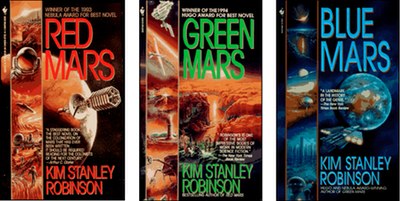 (credit: Bantam Spectra) |
In conducting his research, Robinson drew heavily upon a significant body of scientific literature, most notably the work of Christopher McKay and Martyn Fogg. Robinson was particularly influenced by Fogg’s concept of “synergistic terraforming”. This is the idea that no single technique can work in isolation and that only a combination of several technologies, requiring a massive industrial effort both on the Martian surface and in orbit, could hope to succeed.
| While the full-scale terraforming of Mars will probably not be feasible anytime soon, the topic will undoubtedly continue to be a popular one in science fiction. |
There are, however, some differences between the terraforming techniques portrayed in Robinson’s trilogy and those described in the scientific literature. In a paper published in the journal Nature called “Making Mars Habitable”, McKay and his co-authors described a two-phase approach in which the planet is first warmed by a massive release of carbon dioxide followed by a modification of the atmosphere to scrub out the carbon dioxide and increase the oxygen content. The estimated time scale for this approach was about one hundred years for the first step and up to one hundred thousand years for the second. McKay’s paper limited consideration to technologies that were not far from the contemporary state-of-the-art.12 In contrast, Robinson postulated that through new technologies and a massive synergistic industrial effort, a single-phase approach could create a habitable atmosphere directly.
Instead of terraforming the planet, Frederik Pohl’s novel Man Plus depicted the opposite approach in which the physiology of a human being was altered to suit the Martian environment. The goal of the Man Plus project was to “modify a human body [so] that it would survive on the surface of Mars as readily and safely as a normal man could walk across a Kansas wheat field.”13 After a series of surgical procedures, an American astronaut was transformed into a computer-enhanced Cyborg that successfully established an outpost on Mars. In the sequel Mars Plus, which Pohl co-authored with Thomas T. Thomas, the Cyborgs were augmented by the Creoles, which were halfway between the full Cyborgs and unmodified humans.14
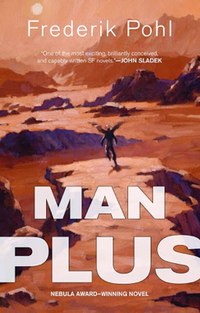 (credit: Orb Books) |
The concept of cybernetically modifying an astronaut or cosmonaut (or taiknonaut) is theoretically feasible. Even before the historic flight of cosmonaut Yuri Gagarin in 1961, a paper published in Astronautics concluded that, “Altering man’s bodily functions to meet the requirements of extraterrestrial environments would be more logical than providing an earthly environment for him in space.”15 Three years after the Astronautics paper, NASA commissioned a report that analyzed the history, development, state-of-the-art and possible future development of artificial lungs, hearts, kidneys, and oxygenating equipment for human spaceflight applications.16 Due to its controversial nature and ethical considerations, however, little further research has been done on this topic.
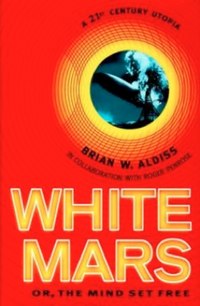 (credit: St. Martin’s Press) |
The cause of Mars exploration suffered a temporary setback in 1999 with the failure of two NASA missions: Mars Polar Lander and Mars Climate Orbiter (the latter of the infamous metric/imperial mix-up). A year later, Brian Aldiss and Roger Penrose’s White Mars was released as a repudiation of Robinson’s trilogy, in which the United Nations declared Mars to be “a sacrosanct environment” that must be preserved “as a place of wonder and meditation.”17 A notable technology mentioned in the novel was the “Zubrin Reactor”, in which atmospheric carbon dioxide was reacted with hydrogen to generate methane fuel and oxygen. This was clearly an homage to aerospace engineer Robert Zubrin and his Mars Direct architecture of using in situ Martian resources to dramatically reduce the cost and complexity of human missions to the Red Planet.18
While the full-scale terraforming of Mars will probably not be feasible anytime soon, the topic will undoubtedly continue to be a popular one in science fiction. Perhaps the conclusion of Martyn Fogg’s seminal paper in The Journal of the British Interplanetary Society is a fitting capstone to all of the works of science fiction that have imagined how to make Mars a nicer place: “The fact that a scenario for the full terraforming of Mars can be conceived within the parameter space of current planetological models, and without violating any known laws of physics, demonstrates that such an idea is, at least, feasible in principle. To bring such a project to fruition would require engineering capabilities greater than those of the present day, but not necessarily out of the question for a future civilization several centuries ahead of our own.”19
1 Burroughs, Edgar Rice Burroughs. A Princess of Mars, A.C. McClurg & Company, 1917.
2 Bradbury, Ray. The Martian Chronicles, Doubleday, 1950.
3 Clarke, Arthur C. The Sands of Mars, Pocket Books, 1952.
4 McKay, Christopher P., Toon, Owen B. and Kastings, James F. “Making Mars Habitable”, Nature, Volume 352, 8 August 1991.
5 Bova, Ben. Mars, Bantam, 1992.
6 Benford, Gregory. The Martian Race, Warner Aspect, 1999.
7 Pohl, Frederik. Mining the Oort, Ballantine Del Rey, 1992.
8 Beatty, J. Kelly, Petersen, Carolyn Collins and Chaikin, Andrew. The New Solar System (4th Edition), Sky Publishing Corp. and Cambridge University Press, 1999.
9 Dyson, Freeman. Disturbing the Universe, HarperCollins Ltd., 1979.
10 Beatty et. al.
11 Wright, Robert. Three Scientists and Their Gods: Looking for Meaning in an Age of Information, Harper & Row, 1998.
12 McKay et. al.
13 Pohl, Frederik. Man Plus, Random House and Orb Books, 1976.
14 Pohl, Frederik and Thomas, Thomas T. Mars Plus, Baen Publishing, 1994.
15 Clynes, Manfred E and Kline, Nathan S. “Cyborgs and Space”, Astronautics, September 1960.
16 Driscoll, Robert W., “Engineering Man for Space: The Cyborg Study”, NASA Biotechnology and Human Research Final Report NASw-512, United Aircraft Corporation, 15 May 1963.
17 Aldiss, Brian W. and Penrose, Roger. White Mars (Or, The Mind Set Free), St. Martin’s Press, 2000.
18 Zubrin, Robert and Wagner, Richard. The Case for Mars: The Plan to Settle the Red Planet and Why We Must, Simon & Schuster Inc, 1996.
19 Fogg, Martyn J., “A Synergistic Approach to Terraforming Mars”, Journal of the British Interplanetary Society, Volume 45, 1992.